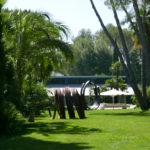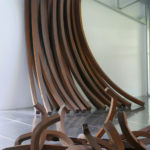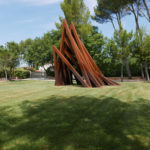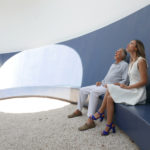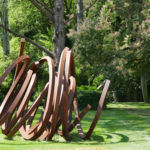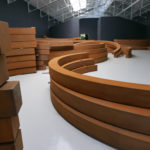By Fanny Revault
From the American adventure of a young man from Provence to the masterful realization of extraordinary sculptures, Bernar Venet’s journey is a striking and impressive one. From early on, the artist conceived an intuitive, audacious and radical body of work that he describes as “self-referential” – a system with its own rules and organization. Both fascinated by the American artistic avant-garde scene and determined to find new ways and gestures to break with art historical tradition, Bernar Venet became, from the 1970s onwards, one of conceptual art’s major figures.
The artist greets us at the Venet Foundation located in Le Muy, an outdoor temple for 20th and 21st century art, displaying lush vegetation encasing his works with undetermined lines, arches or diagonals. These sculptures come alive with contrasts and vibrate under the Southern light. We spoke with the master of this main, whose bold ambition was, from his youth to offer, long before others did, a new approach to art.
When did you start to develop an interest in art ?
I quickly noticed that I was a little more gifted than my schoolfriends when it came to drawing or watercolor and I seized the opportunity to show my difference and to make sure I got noticed somewhere; because I was not any more talented than the next person when it came to traditional school subjects and I really was not good at sports. I was a sickly child and had asthma so I was pretty diminished. So my solution was to express myself through painting. One day, when my mother took me to Digne to buy some oil paints. In the shop window, I discovered a book, a small thing that represented a painting.
But I didn’t know anything about art, the word “art” didn’t exist. So I spoke to the shop owner and I ask him “Excuse me Sir, but what is this? What does “Renoir” mean?” and he replied “Renoir is a very famous artist, a painter exhibited in all the museums of the world”. That day, I had a revelation, and said to myself “Perhaps I don’t have to work at the factory like my grandfather, my mother, my father, my brothers and everyone else in the village.
When you arrived in Nice, you discovered artists from the New Realism movement. What were these encounters and your first productions like?
When I arrived in Nice I did indeed discover artists like Ben, and later Martial Raysse – this was in 1961, 1963 for Arman in. But I was already in an avant-garde dynamic, I created paintings which were completely covered with tar all over of the surface. And the idea was not to create a composition or a painting that represented anything. The idea was merely to represent tar!
How did you find your place in the context of the 1960s?
In the early 1960s, there was a worldwide return to figurative painting. The 50s were covered by abstract art, American abstract expressionism, for instance, and everyone began to either make pop art, or new figurative art as it happened in Paris; or you return to objects with New Realism. And I, I persisted with abstraction, which we could say is an industrial, you see, I paint my pictures with a compressor gun, so it js not the artist’s brushstroke, it is not the expression of an individual, it is very cold work, relatively geometric, and I had to find myself in New York to understand that I was not alone, that there was a whole new avant-garde after pop art, which would end up manifesting, and was named minimal art.
At Arman’s invitation in ’66, you went to New York and met the artists of the avant-garde American scene. What role did they play in your career?
As soon as I arrived, I got the chance to discover an exhibition at the Whitney Museum, which exhibited a lot of minimal artworks, so I was a shock, a revelation, I felt that these were my cousins in a way, my potential family, except that they were all older than me, or at least most of them were most about fifteen years older than me; not all of them, Carl Andre was only 5 or 6 years older ; but in any case I saw a very strong relationship and, of course, in the first year after I arrived in 1966, I could not get these contacts. but in 1967, as soon as I moved to New York, I contacted these artists and became very friendly with them and, of course, I learnt from their rigor and applied it to my work, with my own way of doing things of course, since I did not remain a minimalist, I very quickly went in a much more conceptual direction where language was my priority.
From an early stage, you made bold and radical choice. What is your memory of your conceptual period?
First of all, my memory from this conceptual period is extremely positive, I think that, at this time, I made very radical paintings, that like I said, have nothing to do with figurative and abstract traditions, and I think it’s an important gesture. But you know, the specificity of this gesture was being as equally understood as Duchamp’s bottle rack was at the time. Look at Duchamp who did that in 1916, it took 50 years or 45 years for artists to get the point and to start to develop it.
Subsequently, your artistic language emphasized line …
In 1976 the line has become much more important because it is at that moment, after this break, conceptual first and then a break, that I really invested this domain of the angle, the arc, and also the straight line, first in painting, then with the wooden reliefs, after which the structure itself transformed.
This is an area that has been explored by other artists in the past, but let’s say that I found a direction which was, in my opinion, original enough to be worth exploring.
Why has mathematics been a recurring source of inspiration for your work?
Artists who have made art evolve have often tackled disciplines that did not serve as models to previous form of art. Religion was a main subject in art, then the representation of the body, then nature, geometry, and so on. Things evolve through topics that we explore …
As for me, I was able, thanks to mathematics, to introduce into my art a system of signs that had nothing to do with the figurative tradition or even the abstract tradition of the 1910s. But I do not think I understand mathematics. I use this field to evolve in my art, in the same way as Cezanne painted trees, plants and flowers but was not an expert in botany. In the same way as Malevich who painted circles and square in his paintings but was not a geometrician. Everything happens intuitively, it is not the perfectly rational result of a thought. We evolve in an empirical way and, all of a sudden, we discover spaces that have never been thought out, and we rush in.
It is important to remember that mathematics do not have a huge place in my current sculptural work – despite there being references to geometry since I make angles, straight lines that I call diagonals, arches … But this has more to do with the identity of an artwork.
What do you wish to express through your monumental sculptures?
My sculptures, undefined lines, arcs and angles are “self-referential”, they speak only of themselves; the big collapses have to do with a problem that is completely autonomous. A “self-referential” piece emphasizes the nature of the artwork itself.
They are an attempt to offer new configurations in the field of sculpture, that’s it. Normally, artists compose their works intuitively; they take a steel rod, weld another one there, add a circle, add a triangle; this is the heritage of Malevich and suprematism of course, of constructivism; so we build a work of art intuitively. Then there was the system of minimalists who created their works systematically; that is to say, they predicted in advance that there would be four cubes, which would be a certain size, a rod joining them or that a square divided into nine pieces, according to very specific proportions, all this was designed in advance and manufactured by companies, and that’s it; So it’s another system of composition. I’m work with another system which is the unpredictable: I do not have any idea what the work will look like when it’s done, and again, when I say finished, it is not really the case since I change configurations as often as I can.
I try to discover what I can do that is interesting and has a at least something to do with the history of sculpture to try and offer new things now.
Can you present your foundation created in 2014?
In 2014, I thought that this place, which is pretty nice, let’s say; I thought it might be interesting, perhaps, to make it into a place, a foundation, since Frank Stella was building me a chapel with six great reliefs, that I knew I would acquire a piece by James Turrell one day, that François Morellet created the swimming pool that is here, that we also had this great gallery that might even allow me to exhibit other artists … I thought it would be interesting to share this place with other artists, firstly because, you know, I tend to think that I, I am not only myself, I am a part of us, of the artists of my generation, and therefore we are a kind of family, and I thought it would be nice to showcase artists who were very generous towards me, allowing me to exhibit alongside them in great galleries such as Douane, and Castelli and Paula Cooper from the start; I give a work of art to receive money, my thought is that it’s just as well to transform this money into an artwork immediately, and especially, to give it to society, because thanks to society I have been able to develop all my work and to reach a certain level of result.
For you, what is a masterpiece?
Artists of the minimalist period were totally opposed to the concept of masterpiece, they thought we had to have a work system, a thought system, and from there, there were no a masterpieces above any other, it was a very subjective thing. I agreed when I was doing my work which belongs to the conceptual period; but today, I have changed my mind, I think that there is a moment, when, suddenly, there is a work that shows an excellencea, a culmination, a much more concentrated juice, which suggests that there really is a much more significant demonstration there than in other works. The masterpiece is the moment when the demonstration is absolutely perfect.
According to you, why is art important in our lives?
Art can indeed be very important in life. First, art allows us to help our consciousness evolve, and to appreciate things that nobody appreciated before we did; Let me give you an example: take a character like Cezanne, who in his time, was the most sophisticated individual on earth in the art field. There was no one sharper than him, he was a sort of visionary. Well, if you took Mr. Cezanne today, woke him up from the dead, took him to a Rothko painting – bearing in mind everyone appreciates Rothko today, you and I, and everyone in the world is sensitive to this quality, to this sensitive painting; and you put Cezanne in front of that and ask: “Mr Cézanne, what do you think of that?”, and he will tell you “Why, what? Oh, it’s a painting? and will someone finish it some day? “,” Oh, no, this is its finished state” … You see, Cezanne, would not understand today, due of course, to the vision he had at the time, the consciousness he had at the time, he would not understand what is happening; and we, as ordinary people, are able to appreciate a Rothko. This means that our consciousness, our sensitivity has evolved considerably, the artists have taught us to discover not simply beauty, but something exceptional, sensitive, that the past was not yet able to perceive.
After the fame, what is your next goal?
Well, fame … we are only famous to people who know who we are, that’s all, it is important to remain very modest. I remember, one day, I was with Andy Warhol, and I said to him “Andy, you know, what’s so great about you is that you know you’re part of history, at the highest possible level”; he looked at me and he said “On a certain level, I guess, but you know, nobody thinks I’m Picasso. As for Picasso, you know what he thinks? Picasso believes that no one thinks he is Leonardo Da Vinci or Michelangelo “… You see, there is always something, it all depends on the models we have. I say to myself every day “How could I do something interesting, good, worthy of history?” Because the goal is not to be recognized today, to sell my work and to be exhibited everywhere, this is absolutely not the point; the only goal, the one and only goal, and Cézanne thought so at the time, I’ll tell you, is that in 200 or 300 years, we can say “But look, what he was able to think of showing us back then”: that is to deserve history; to have made a gesture, to have demonstrated, to have added culture to humanity, that is the only goal.


The Venet Foundation – Bernar Venet – Credit photo : Etienne Revault

The Venet Foundation – Bernar Venet – Credit photo : Etienne Revault

The Venet Foundation – Bernar Venet – Credit photo : Etienne Revault

The Venet Foundation – Bernar Venet et Fanny Revault – Credit photo : Etienne Revault

The Venet Foundation – Bernar Venet – Credit photo : Etienne Revault

The Venet Foundation – Bernar Venet et Fanny Revault – Credit photo : Etienne Revault

The Venet Foundation – Bernar Venet – Credit photo : Etienne Revault

The Venet Foundation – Bernar Venet – Credit photo : Etienne Revault

The Venet Foundation – Bernar Venet – Credit photo : Etienne Revault

The Venet Foundation – Bernar Venet – Credit photo : Etienne Revault

The Venet Foundation – Bernar Venet – Credit photo : Etienne Revault

The Venet Foundation – Bernar Venet – Credit photo : Etienne Revault

The Venet Foundation – Bernar Venet et Fanny Revault – Credit photo : Etienne Revault

The Venet Foundation – Bernar Venet – Credit photo : Etienne Revault

The Venet Foundation – Bernar Venet – Credit photo : Etienne Revault

The Venet Foundation – Bernar Venet – Credit photo : Etienne Revault

The Venet Foundation – Bernar Venet – Credit photo : Etienne Revault

The Venet Foundation – Bernar Venet et Fanny Revault – Credit photo : Etienne Revault

The Venet Foundation – Bernar Venet – Credit photo : Etienne Revault

The Venet Foundation – Bernar Venet – Credit photo : Etienne Revault

The Venet Foundation – Bernar Venet – Credit photo : Etienne Revault

The Venet Foundation – Bernar Venet – Credit photo : Etienne Revault

The Venet Foundation – Bernar Venet – Credit photo : Etienne Revault

The Venet Foundation – Bernar Venet – Credit photo : Etienne Revault

The Venet Foundation – Bernar Venet – Credit photo : Etienne Revault

The Venet Foundation – Bernar Venet – Credit photo : Etienne Revault
